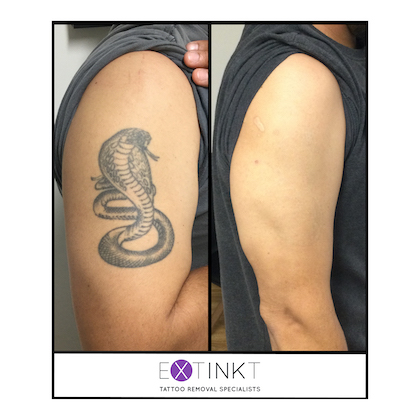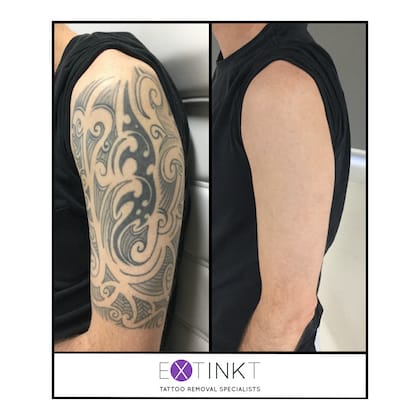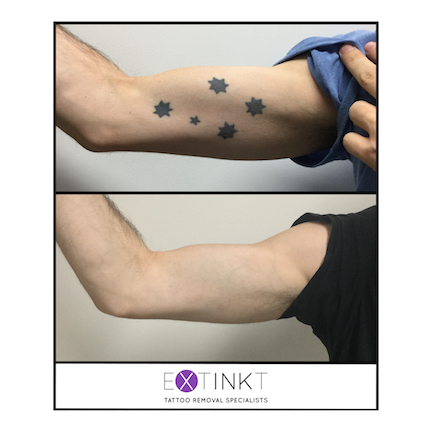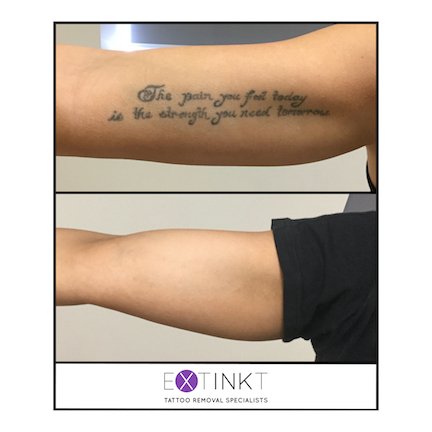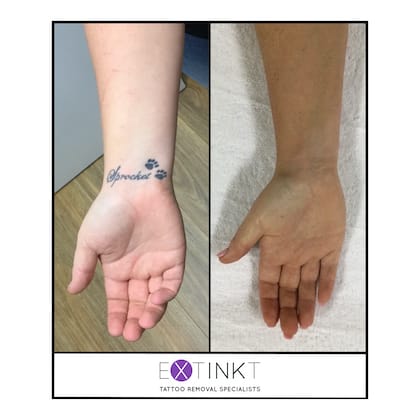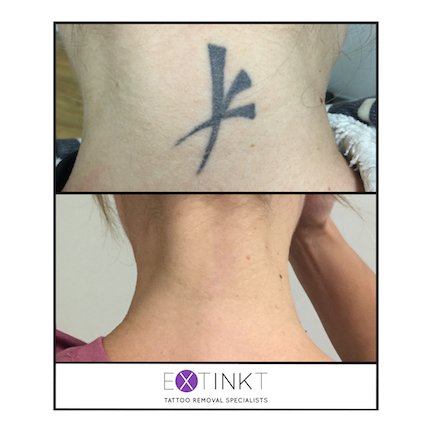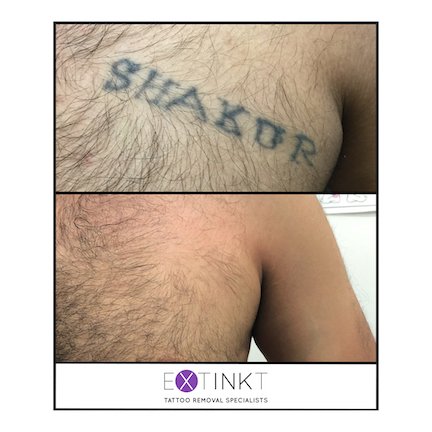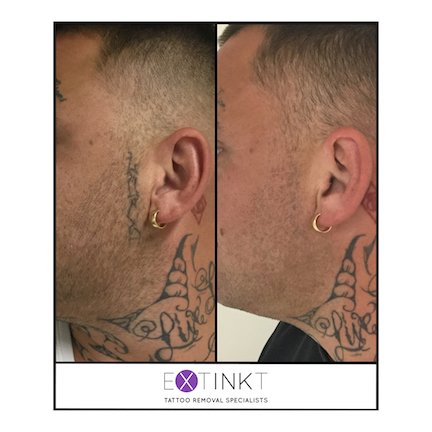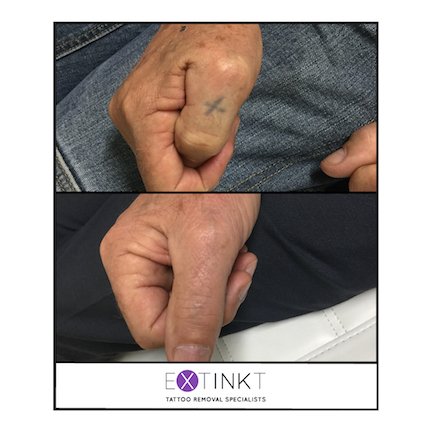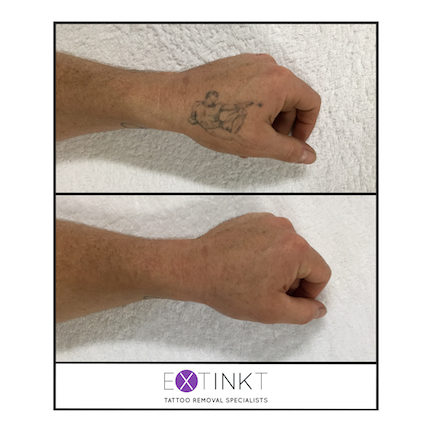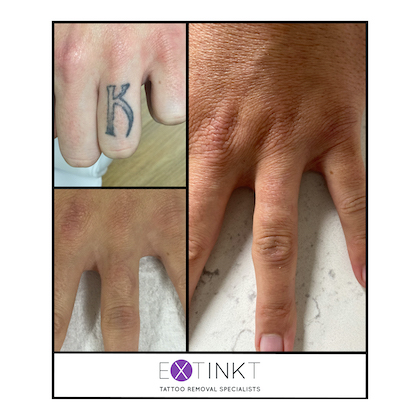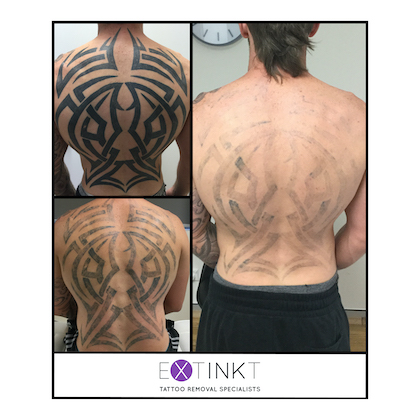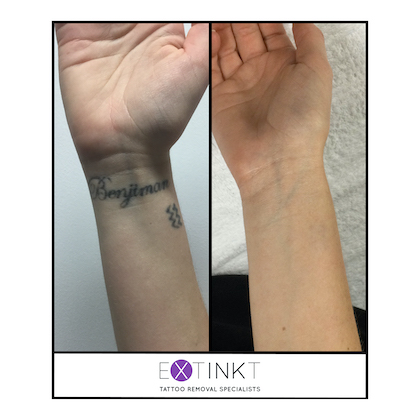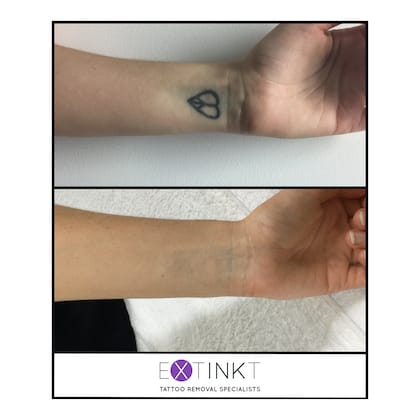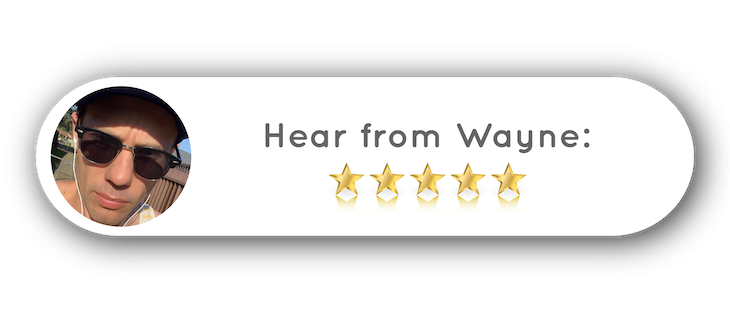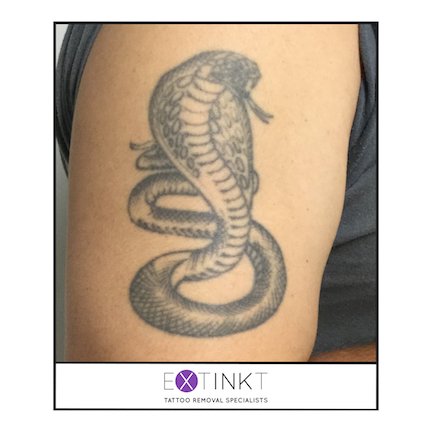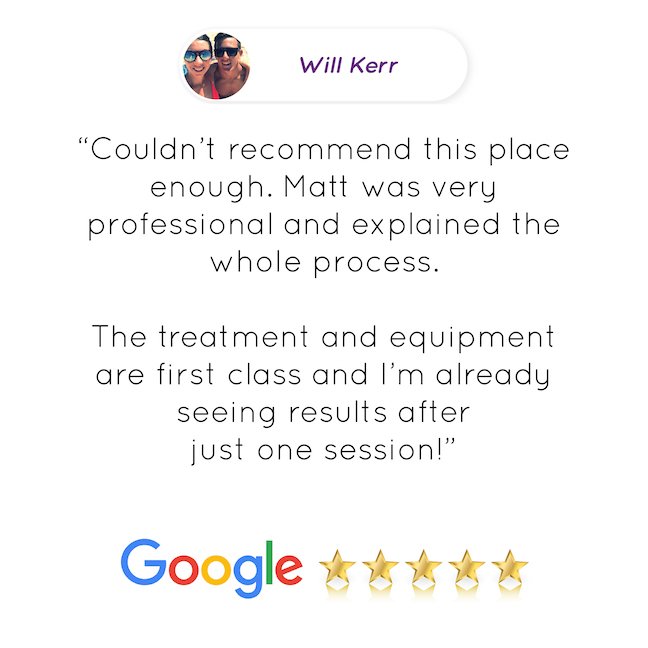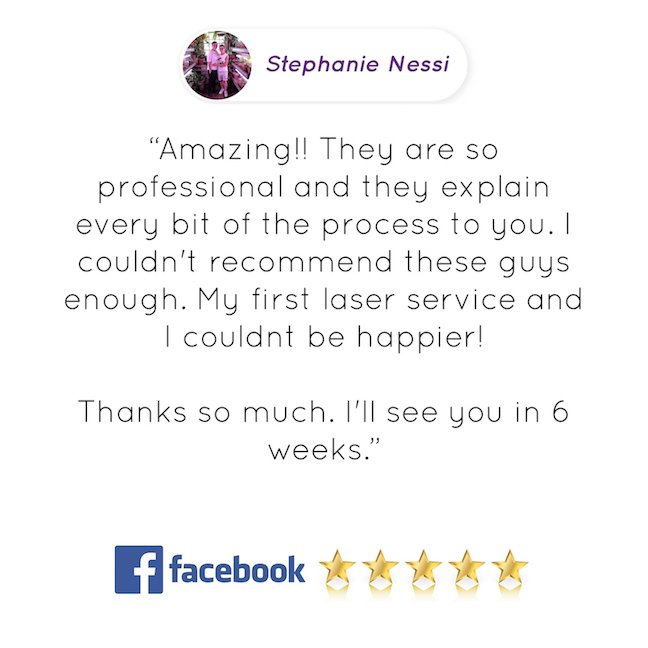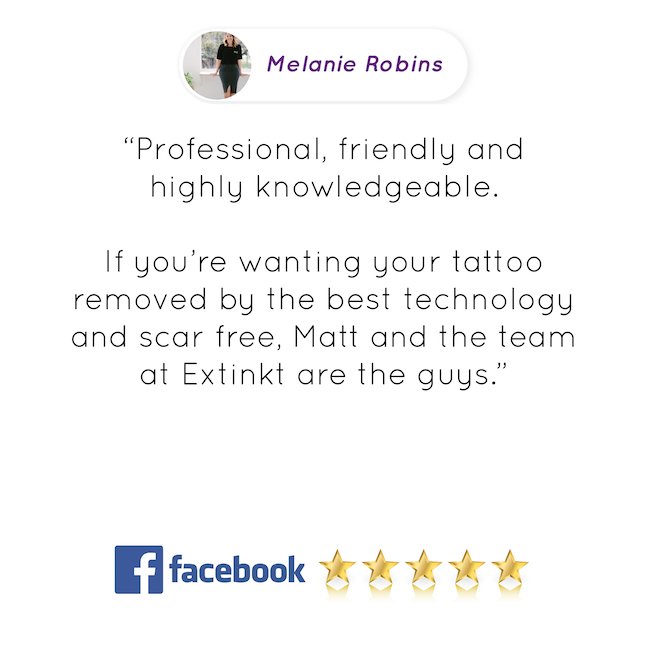Laser Tattoo Removal Sydney
Extinkt deliver a premier service for tattoo removal in Sydney's Macarthur region. Our specialists operate medical grade laser technology, allowing us to treat a variety of tattoo colours. With extremely short pulses of laser light, we're able to break down the tattoo ink particles into much smaller fragments.
This allows your body to naturally clear it away safely and effectively, without any damage to surrounding skin. We also offer complimentary skin rejuvenation for advanced healing and resurfacing of the treated area.
As Campbelltown's dedicated specialists, we provide an exceptionally high standard of care, practicing with our clients safety, privacy and well-being as the top priority. Please feel free to take a tour of our clinic by using the Google 360° interactive image. You can also book an appointment online, use our contact form, or call us on (02) 4656 2930.
Campbelltown's Premier Clinic
Since 2016, we remain the only specialist provider of tattoo removal in Campbelltown. We conduct thousands of expert treatments each year on a variety of skin types. By delivering a service of the absolute highest standard, we aim to continue as a leading provider of tattoo removal in Sydney.
In 2017, we were honoured to be recognised for our efforts, accepting the award for Campbelltown’s Outstanding New Business. Our clients can be confident they are in good hands throughout their journey towards clean skin. All are given the opportunity to have any questions answered during a free initial assessment.
With an evidence based approach to practice, we have combined leading technology and treatment techniques with an excellent level of customer service. Please browse through some of our recent results here.
Be Happy With Your Skin!
Laser tattoo removal treatments provide clients with the opportunity to be happy in their skin, but they can also be an option for those wishing to fade or modify a tattoo they’re not currently happy with. In many cases fewer treatments are needed before a new tattoo can be applied on top.
Laser fading creates more options for new art and helps to make sure no traces of the unwanted tattoo visibly show through. In our experience, tattoos can be faded well enough in as little as 2-3 treatments.
Our unique approach to tattoo removal was formed with the aim to provide the highest standard of care for all those seeking treatment. This includes regularly monitoring the best available evidence in the industry and also collaborating with highly regarded tattoo removal experts and dermatologists to bring you the results you deserve.
Lets Be Friends!
Book an appointment online, call or get in touch via social media!
Latest News
Tattoo Removal Tech Talk
An Important Approach To This Topic.
We wanted our take on this subject to be as evidence based as possible, where rather than trying to tell you one laser system is your only option, our aim is to provide you with more knowledge on the top machines and on how to make sure you’ll be safe. This article takes into consideration what we believe to be the best performing picosecond and nanosecond machines currently being used for tattoo removal in Sydney: The Quanta Discovery Pico, The Quanta Q-Plus C Evo, and The Syneron Candela PicoWay.
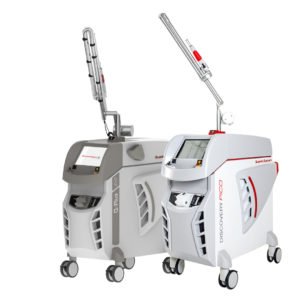 When beginning tattoo removal, it’s crucial you do so based on what the outcome of your treatments will be. Choosing a clinic that doesn‘t provide any evidence of results will more than likely end in disappointment. Most machine manufacturers market their product as being more advanced than any other, and these claims are commonly pushed by tattoo removal clinics in their advertising to convince potential clients to partner with them, often without even mentioning any results they’ve achieved.
When beginning tattoo removal, it’s crucial you do so based on what the outcome of your treatments will be. Choosing a clinic that doesn‘t provide any evidence of results will more than likely end in disappointment. Most machine manufacturers market their product as being more advanced than any other, and these claims are commonly pushed by tattoo removal clinics in their advertising to convince potential clients to partner with them, often without even mentioning any results they’ve achieved.
Before we start, it’s important to stress that we in no way recommend you visit a clinic operating with a PicoSure laser. Please visit this link should you need any more information.
One current hot topic surrounds the concept that picosecond systems can produce quicker results than their nanosecond counterparts, and you may have heard that picosecond machines are faster. We’ve come across a number of statements claiming them to be anywhere from ‘100 times’ to ‘1000 times’ faster than nanosecond machines. But what does the ‘speed’ actually refer to?
An easy mistake to make is thinking of the speed like driving a car. In fact, it’s the speed that the laser switches off after it makes contact with your tattoo…just like an extremely fast light switch. The Quanta & Syneron Pico machines switch off after 450 picoseconds (0.45 nanoseconds) when treating black ink, while our Q-Plus C Evo switches off after 6 nanoseconds.
With some quick math (feel free to check yourself), this means both pico machines only switch off 13 times faster than the Q-Plus C Evo, not even close to the claim of ‘1000 times faster’. Even so, why is this being considered more efficient in theory?

The greatest claim is that it allows more ink to break down per treatment, by creating a larger photo-acoustic (shock) effect. This has been exaggerated through animated images and videos, but no real evidence exists of it actually being the case. While the specs are appealing on paper, there are no case studies available (not even level 5 evidence) to back up the claims. Considering they’ve been on the market for a number of years, the comparative data should be available. Further, there have been no split tests with the Discovery Pico (which houses both technologies) to compare the two settings. By splitting a number of centrally located tattoos right down the middle, treating one side pico and one side nano, the differences should supposedly be clear. As the data is not available, the question must be asked: Is the difference in speed not enough to show any significant difference in results?
When reviewing research articles published through the National Center for Biotechnology Information (NCBI) – part of the United States National Library of Medicine – we found no evidence comparing any of the machines mentioned in this article. In fact, the only comparisons available looked at outdated pico and nano technology with very different specifications. To strengthen this point, one of Sydney’s longest serving tattoo removal specialists is still using nanosecond technology and produces results which are undoubtedly the best in Australia.
One aspect of pico technology we enjoy is the idea that faster lasers will produce less heat (the faster you turn a light on and off, the less heat generated). This can contribute to reducing the possibility of short term side effects or even speed up the healing process after your treatment. Again however, no true evidence exists comparing differences between the 3 machines in this article, and as far as we understand no numerical values indicative of heat production have been reported. With the differences in speed measuring just 5.55 billionths of a second between the technologies, we’re interested in what these values might be.
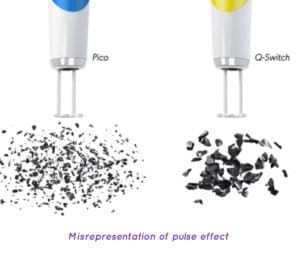 Further, both the Quanta Discovery Pico and Quanta Q-Plus C Evo have exactly the same laser to treat blue and green inks. Should you be deciding between the two and have these colours, there is no need to choose based on the machine, as there is no difference in the speed (just be confident in your laser specialist). On the other hand, the PicoWay uses a different laser to treat these colours, which is unique to the PicoWay only. As this reasonably new addition has been available for more than 12 months, it could be suggested that any real advancements for treating with this wavelength would now be apparent, however at this time there is no indication.
Further, both the Quanta Discovery Pico and Quanta Q-Plus C Evo have exactly the same laser to treat blue and green inks. Should you be deciding between the two and have these colours, there is no need to choose based on the machine, as there is no difference in the speed (just be confident in your laser specialist). On the other hand, the PicoWay uses a different laser to treat these colours, which is unique to the PicoWay only. As this reasonably new addition has been available for more than 12 months, it could be suggested that any real advancements for treating with this wavelength would now be apparent, however at this time there is no indication.
Another point to consider when comparing the 3 systems is the considerably higher peak power of the Quanta machines (ability to hit harder) when compared with the Picoway. While we feel this is important based on experience treating more difficult tattoos, it is again hard to comment on without any true evidence. As far as our own research goes, we’d say that there are a number of clinics operating with Quanta System technology that have more extensive portfolios than those operating with a PicoWay machine. This could however be due to a variety of different reasons not only including the machine capabilities. We’re also confident the discomfort is similar with all systems, from both experience and client feedback. In specialist clinics this can be managed with chilled air, numbing cream and regular breaks during treatment.
We’d like to sum up this post by answering the following 2 questions: Is it advantageous for the laser to fire as quickly as possible? The answer is YES. Is there any conclusive data (at all) comparing the 3 machines of this article? The answer is NO. If anyone would like to contact us with any uncertainties about this topic, please feel free to do so. We’ve never come across an article written in this way before, so we’d love to hear from both clients and fellow laser specialists with their thoughts. We’d also like to call on operators of the Quanta Discovery to conduct high quality clinical trials comparing the pico and nano settings. It is important for the tattoo removal industry to have this information available and you have the opportunity to be at the forefront of the research.
On a final note, we’d like to say this does not necessarily mean these are the only machines you should consider, but they are our top three choices. Machine specs do matter, but the best way to check is to look at the clinics portfolio. Should you be searching and are a little unsure, make sure they have a good catalogue of results achieved in the clinic, start with a test patch and don’t commit to any long term packages unless you’re completely confident.

Tattoo Removal Tech Talk
An Important Approach To This Topic.
We wanted our take on this subject to be as evidence based as possible, where rather than trying to tell you one laser system is your only option, our aim is to provide you with more knowledge on the top machines and on how to make sure you’ll be safe. This article takes into consideration what we believe to be the best performing picosecond and nanosecond machines currently being used for tattoo removal in Sydney: The Quanta Discovery Pico, The Quanta Q-Plus C Evo, and The Syneron Candela PicoWay.
 When beginning tattoo removal, it’s crucial you do so based on what the outcome of your treatments will be. Choosing a clinic that doesn‘t provide any evidence of results will more than likely end in disappointment. Most machine manufacturers market their product as being more advanced than any other, and these claims are commonly pushed by tattoo removal clinics in their advertising to convince potential clients to partner with them, often without even mentioning any results they’ve achieved.
When beginning tattoo removal, it’s crucial you do so based on what the outcome of your treatments will be. Choosing a clinic that doesn‘t provide any evidence of results will more than likely end in disappointment. Most machine manufacturers market their product as being more advanced than any other, and these claims are commonly pushed by tattoo removal clinics in their advertising to convince potential clients to partner with them, often without even mentioning any results they’ve achieved.
Before we start, it’s important to stress that we in no way recommend you visit a clinic operating with a PicoSure laser. Please visit this link should you need any more information.
One current hot topic surrounds the concept that picosecond systems can produce quicker results than their nanosecond counterparts, and you may have heard that picosecond machines are faster. We’ve come across a number of statements claiming them to be anywhere from ‘100 times’ to ‘1000 times’ faster than nanosecond machines. But what does the ‘speed’ actually refer to?
An easy mistake to make is thinking of the speed like driving a car. In fact, it’s the speed that the laser switches off after it makes contact with your tattoo…just like an extremely fast light switch. The Quanta & Syneron Pico machines switch off after 450 picoseconds (0.45 nanoseconds) when treating black ink, while our Q-Plus C Evo switches off after 6 nanoseconds.
With some quick math (feel free to check yourself), this means both pico machines only switch off 13 times faster than the Q-Plus C Evo, not even close to the claim of ‘1000 times faster’. Even so, why is this being considered more efficient in theory?

The greatest claim is that it allows more ink to break down per treatment, by creating a larger photo-acoustic (shock) effect. This has been exaggerated through animated images and videos, but no real evidence exists of it actually being the case. While the specs are appealing on paper, there are no case studies available (not even level 5 evidence) to back up the claims. Considering they’ve been on the market for a number of years, the comparative data should be available. Further, there have been no split tests with the Discovery Pico (which houses both technologies) to compare the two settings. By splitting a number of centrally located tattoos right down the middle, treating one side pico and one side nano, the differences should supposedly be clear. As the data is not available, the question must be asked: Is the difference in speed not enough to show any significant difference in results?
When reviewing research articles published through the National Center for Biotechnology Information (NCBI) – part of the United States National Library of Medicine – we found no evidence comparing any of the machines mentioned in this article. In fact, the only comparisons available looked at outdated pico and nano technology with very different specifications. To strengthen this point, one of Sydney’s longest serving tattoo removal specialists is still using nanosecond technology and produces results which are undoubtedly the best in Australia.
One aspect of pico technology we enjoy is the idea that faster lasers will produce less heat (the faster you turn a light on and off, the less heat generated). This can contribute to reducing the possibility of short term side effects or even speed up the healing process after your treatment. Again however, no true evidence exists comparing differences between the 3 machines in this article, and as far as we understand no numerical values indicative of heat production have been reported. With the differences in speed measuring just 5.55 billionths of a second between the technologies, we’re interested in what these values might be.
 Further, both the Quanta Discovery Pico and Quanta Q-Plus C Evo have exactly the same laser to treat blue and green inks. Should you be deciding between the two and have these colours, there is no need to choose based on the machine, as there is no difference in the speed (just be confident in your laser specialist). On the other hand, the PicoWay uses a different laser to treat these colours, which is unique to the PicoWay only. As this reasonably new addition has been available for more than 12 months, it could be suggested that any real advancements for treating with this wavelength would now be apparent, however at this time there is no indication.
Further, both the Quanta Discovery Pico and Quanta Q-Plus C Evo have exactly the same laser to treat blue and green inks. Should you be deciding between the two and have these colours, there is no need to choose based on the machine, as there is no difference in the speed (just be confident in your laser specialist). On the other hand, the PicoWay uses a different laser to treat these colours, which is unique to the PicoWay only. As this reasonably new addition has been available for more than 12 months, it could be suggested that any real advancements for treating with this wavelength would now be apparent, however at this time there is no indication.
Another point to consider when comparing the 3 systems is the considerably higher peak power of the Quanta machines (ability to hit harder) when compared with the Picoway. While we feel this is important based on experience treating more difficult tattoos, it is again hard to comment on without any true evidence. As far as our own research goes, we’d say that there are a number of clinics operating with Quanta System technology that have more extensive portfolios than those operating with a PicoWay machine. This could however be due to a variety of different reasons not only including the machine capabilities. We’re also confident the discomfort is similar with all systems, from both experience and client feedback. In specialist clinics this can be managed with chilled air, numbing cream and regular breaks during treatment.
We’d like to sum up this post by answering the following 2 questions: Is it advantageous for the laser to fire as quickly as possible? The answer is YES. Is there any conclusive data (at all) comparing the 3 machines of this article? The answer is NO. If anyone would like to contact us with any uncertainties about this topic, please feel free to do so. We’ve never come across an article written in this way before, so we’d love to hear from both clients and fellow laser specialists with their thoughts. We’d also like to call on operators of the Quanta Discovery to conduct high quality clinical trials comparing the pico and nano settings. It is important for the tattoo removal industry to have this information available and you have the opportunity to be at the forefront of the research.
On a final note, we’d like to say this does not necessarily mean these are the only machines you should consider, but they are our top three choices. Machine specs do matter, but the best way to check is to look at the clinics portfolio. Should you be searching and are a little unsure, make sure they have a good catalogue of results achieved in the clinic, start with a test patch and don’t commit to any long term packages unless you’re completely confident.

Tattoo Removal Tech Talk
An Important Approach To This Topic.
We wanted our take on this subject to be as evidence based as possible, where rather than trying to tell you one laser system is your only option, our aim is to provide you with more knowledge on the top machines and on how to make sure you’ll be safe. This article takes into consideration what we believe to be the best performing picosecond and nanosecond machines currently being used for tattoo removal in Sydney: The Quanta Discovery Pico, The Quanta Q-Plus C Evo, and The Syneron Candela PicoWay.
 When beginning tattoo removal, it’s crucial you do so based on what the outcome of your treatments will be. Choosing a clinic that doesn‘t provide any evidence of results will more than likely end in disappointment. Most machine manufacturers market their product as being more advanced than any other, and these claims are commonly pushed by tattoo removal clinics in their advertising to convince potential clients to partner with them, often without even mentioning any results they’ve achieved.
When beginning tattoo removal, it’s crucial you do so based on what the outcome of your treatments will be. Choosing a clinic that doesn‘t provide any evidence of results will more than likely end in disappointment. Most machine manufacturers market their product as being more advanced than any other, and these claims are commonly pushed by tattoo removal clinics in their advertising to convince potential clients to partner with them, often without even mentioning any results they’ve achieved.
Before we start, it’s important to stress that we in no way recommend you visit a clinic operating with a PicoSure laser. Please visit this link should you need any more information.
One current hot topic surrounds the concept that picosecond systems can produce quicker results than their nanosecond counterparts, and you may have heard that picosecond machines are faster. We’ve come across a number of statements claiming them to be anywhere from ‘100 times’ to ‘1000 times’ faster than nanosecond machines. But what does the ‘speed’ actually refer to?
An easy mistake to make is thinking of the speed like driving a car. In fact, it’s the speed that the laser switches off after it makes contact with your tattoo…just like an extremely fast light switch. The Quanta & Syneron Pico machines switch off after 450 picoseconds (0.45 nanoseconds) when treating black ink, while our Q-Plus C Evo switches off after 6 nanoseconds.
With some quick math (feel free to check yourself), this means both pico machines only switch off 13 times faster than the Q-Plus C Evo, not even close to the claim of ‘1000 times faster’. Even so, why is this being considered more efficient in theory?

The greatest claim is that it allows more ink to break down per treatment, by creating a larger photo-acoustic (shock) effect. This has been exaggerated through animated images and videos, but no real evidence exists of it actually being the case. While the specs are appealing on paper, there are no case studies available (not even level 5 evidence) to back up the claims. Considering they’ve been on the market for a number of years, the comparative data should be available. Further, there have been no split tests with the Discovery Pico (which houses both technologies) to compare the two settings. By splitting a number of centrally located tattoos right down the middle, treating one side pico and one side nano, the differences should supposedly be clear. As the data is not available, the question must be asked: Is the difference in speed not enough to show any significant difference in results?
When reviewing research articles published through the National Center for Biotechnology Information (NCBI) – part of the United States National Library of Medicine – we found no evidence comparing any of the machines mentioned in this article. In fact, the only comparisons available looked at outdated pico and nano technology with very different specifications. To strengthen this point, one of Sydney’s longest serving tattoo removal specialists is still using nanosecond technology and produces results which are undoubtedly the best in Australia.
One aspect of pico technology we enjoy is the idea that faster lasers will produce less heat (the faster you turn a light on and off, the less heat generated). This can contribute to reducing the possibility of short term side effects or even speed up the healing process after your treatment. Again however, no true evidence exists comparing differences between the 3 machines in this article, and as far as we understand no numerical values indicative of heat production have been reported. With the differences in speed measuring just 5.55 billionths of a second between the technologies, we’re interested in what these values might be.
 Further, both the Quanta Discovery Pico and Quanta Q-Plus C Evo have exactly the same laser to treat blue and green inks. Should you be deciding between the two and have these colours, there is no need to choose based on the machine, as there is no difference in the speed (just be confident in your laser specialist). On the other hand, the PicoWay uses a different laser to treat these colours, which is unique to the PicoWay only. As this reasonably new addition has been available for more than 12 months, it could be suggested that any real advancements for treating with this wavelength would now be apparent, however at this time there is no indication.
Further, both the Quanta Discovery Pico and Quanta Q-Plus C Evo have exactly the same laser to treat blue and green inks. Should you be deciding between the two and have these colours, there is no need to choose based on the machine, as there is no difference in the speed (just be confident in your laser specialist). On the other hand, the PicoWay uses a different laser to treat these colours, which is unique to the PicoWay only. As this reasonably new addition has been available for more than 12 months, it could be suggested that any real advancements for treating with this wavelength would now be apparent, however at this time there is no indication.
Another point to consider when comparing the 3 systems is the considerably higher peak power of the Quanta machines (ability to hit harder) when compared with the Picoway. While we feel this is important based on experience treating more difficult tattoos, it is again hard to comment on without any true evidence. As far as our own research goes, we’d say that there are a number of clinics operating with Quanta System technology that have more extensive portfolios than those operating with a PicoWay machine. This could however be due to a variety of different reasons not only including the machine capabilities. We’re also confident the discomfort is similar with all systems, from both experience and client feedback. In specialist clinics this can be managed with chilled air, numbing cream and regular breaks during treatment.
We’d like to sum up this post by answering the following 2 questions: Is it advantageous for the laser to fire as quickly as possible? The answer is YES. Is there any conclusive data (at all) comparing the 3 machines of this article? The answer is NO. If anyone would like to contact us with any uncertainties about this topic, please feel free to do so. We’ve never come across an article written in this way before, so we’d love to hear from both clients and fellow laser specialists with their thoughts. We’d also like to call on operators of the Quanta Discovery to conduct high quality clinical trials comparing the pico and nano settings. It is important for the tattoo removal industry to have this information available and you have the opportunity to be at the forefront of the research.
On a final note, we’d like to say this does not necessarily mean these are the only machines you should consider, but they are our top three choices. Machine specs do matter, but the best way to check is to look at the clinics portfolio. Should you be searching and are a little unsure, make sure they have a good catalogue of results achieved in the clinic, start with a test patch and don’t commit to any long term packages unless you’re completely confident.

Tattoo Removal Tech Talk
An Important Approach To This Topic. We wanted our take on this subject to ..Read more
The Extinkt Tattoo Removal Christmas Sale!
Our Biggest Offer To Date. This Christmas, we’re offering a very limited ..Read more
Meet Your Extinkt Tattoo Removal Specialists
A Little More Info About Who We Are. We wanted to let you know some [&hel..Read more
Book Online Today
When you’re ready to say goodbye to your ink, don’t hesitate to get in touch. Please feel free to use our online booking system, where selected appointments have been made available for your convenience. You can book a free consultation or returning treatment session at any time through our online system.
If the times listed don’t fit in with your schedule, we do also have other times available. You can fill out our contact form, or give us a call on (02) 4656 2930.
Don’t forget, we’re more than happy to provide you with a test patch before you go ahead with your first full tattoo removal treatment. We look forward to welcoming you to South West Sydney’s Premier Laser Clinic. What are you waiting for, you’ve got nothing to lose, except your tattoo!

Troy:
"I cannot say enough about Matt and the team from Extinkt. Their expertise is second to none, but more importantly their service is incredible. They talk you through every step of the way and follow up to ensure everything’s going as planned.
After one session I can already see better results than I've had from several sessions elsewhere. Cannot recommend these guys enough!"

Wayne:
"If you have considered laser tattoo removal I'd definitely recommend the team at Extinkt. Matt and Joel have been honest throughout my treatment process as well as providing me with a realistic and affordable treatment plan.
Thanks boys, awesome job!"
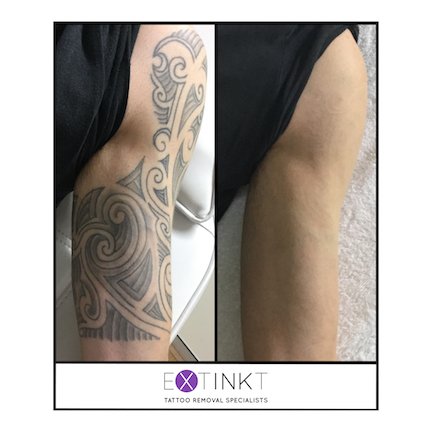
Lance:
"I went to Extinkt Tattoo Removal after an unhappy experience at another removal practise. Not only were they very professional, but they actually care about their clientele. The initial consultation answered all my questions and put my mind at ease. The process itself was 50 % less painful than my previous treatment.
They even gave me an aftercare package and followed up with a call a day later to see how I was. 2 sessions with Extinkt was enough for me to cover over with a new tattoo. I would highly recommend them."


